PLT recently collaborated with our friends at Natural Start Alliance (a program of the North American Association of Environmental Education) to host a free educator webinar full of ideas for creating fun, authentic outdoor learning experiences for ages 1-6.
Tarneshia Evans and Sheila Williams Ridge, two amazing PLT facilitators, shared tips and tricks as they demonstrated a couple of their favorite activities from PLT’s newest activity guide for early childhood educators and caregivers: Trees & Me: Activities for Exploring Nature with Young Children.

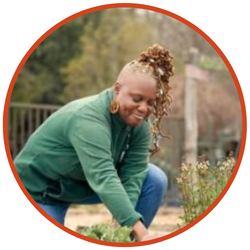 Discovering how plants and animals depend on trees with Tarneshia
Discovering how plants and animals depend on trees with Tarneshia
Tarneshia Evans is an experienced educator and advocate for nature-based early childhood education. She has been working in the field of education for over 20 years, most recently at The Visual Arts Center and Cultural Arts Center of Glen Allen.
Are trees good for wildlife?
What kinds of trees?
Living trees? Dead trees? Standing? Fallen?
What if I told you the answer is a resounding “YES!” to all of the above?
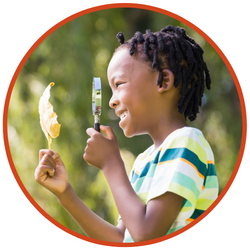
You might not be surprised to learn that trees are used as a food source and shelter by squirrels and birds — but what about raccoons, black bears, frogs, and beetles?
We are often more aware of what we can easily observe in daylight, especially activity happening in healthy trees, but there are many surprises to be found in dead and fallen trees, too! For example, many are unaware of how incredibly important snags, standing dead or dying trees, are, and why they are considered “wildlife trees.”
Snags provide important shelter for lots of different kinds of wildlife. The wood of a tree (xylem) is hard when the tree is alive, but once a tree dies, it is invaded by fungi that work to decompose it. As the wood decomposes, it becomes softer, making it easier for birds and mammals to construct nesting cavities, and for insects to borrow.
Tarneshia’s Favorite Ideas
Use PLT’s Trees & Me activities for ideas and activities for young children to freely explore how trees support plant and animal life.
- One idea is to request photographs from local foresters and wildlife centers of all the regional plants and animals that depend on native forests in your area. Hang the pictures in the center of your classroom and ask kids to pretend to be wildlife biologists, investigating the relationships between forests and the animals that call them home.
- Other ideas are to play tree observation bingo or a schoolyard scavenger hunt to help kids make the connection to how plants, humans, and animals depend on a healthy environment – and you don’t have to create your own from scratch!
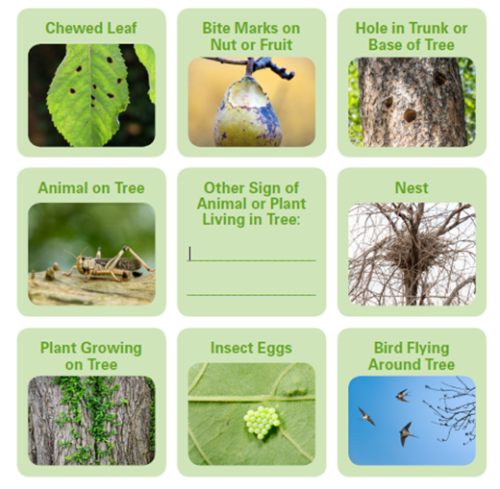
Check out these and many other templates and free student pages by logging into PLT.org – creating a free account only takes a minute, and once you have, you’ll unlock lots of engaging supplemental resources to keep the lesson going.
Access supporting resources
Create a free account to access these and other resources at plt.org/treesandme
- Downloadable family pages and ready-to-go resources
- Leaf Through the Guide, an interactive online tutorial
- Correlations to Head Start, NAEYC and other early learning standards

 Respecting and appreciating the role of trees in our lives with Sheila
Respecting and appreciating the role of trees in our lives with Sheila
Sheila Williams Ridge is an author, educator, and naturalist who serves as Director of the Child Development Lab School at the University of Minnesota. She has a bachelor’s degree in biology, a master’s degree in education, and previously taught preschool.
When we teach about nature and trees, it’s important to practice and model respect and gratitude.
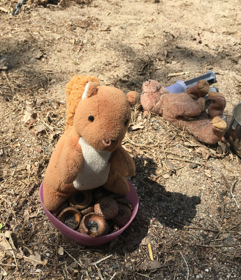
Gratitude for all that forests provide us, for the fact that a sustainably-managed forest can support us for generations and generations. They provide some more obvious wood products, like the beams that build the homes we live in, the desks we learn in, and habitat animals call home – but also the invisible benefits like addressing climate change, and cleaner air and water! It’s important to talk with young children about the importance of urban trees, of the importance of shade, and ways for learners to plant trees to reduce heat in playgrounds and in their neighborhoods.
How can you connect kids to trees and celebrate them?
Sheila’s Favorite Ideas
Do you have fruit trees where you live? Acorns or pinecones?
Folks in the webinar shared about the pine nuts, oak acorns, cherry trees, apple trees, citrus trees, and serviceberries they find near where they live. These are all examples of food for humans and food for wildlife.
- One idea for helping children make this connection is to put stuffed animals depicting wildlife (bears, racoons, foxes, etc.) outside to see and engage with the animals that depend on the trees in your environment. A tip: focus on connecting children to the beauty of their local environment, of the trees and nature native to where they live.

PLT’s Trees & Me guide suggests lots of ways to embed the idea of giving thanks and modeling gratitude in your curriculum and is full of ideas to authentically connect children to their environment.
- One way we talk about playing on trees with respect and gratitude is the idea of listening to the sounds of groaning trees. Just like people, if you tug on trees, you might hear groaning. That is the tree’s way of asking you to stop, and we need to listen to and respect trees with “gentle climbing”.
- Breathing in gratitude, or centering yourself on the gift of air, is another way to exercise this practice. To remind children of the ability of just two trees to provide enough oxygen for a family of four. Another idea: try learning the Indigenous words for “thank you” and “trees” in the area you live, as some trees have been around long enough to remember when these languages were spoken exclusively.
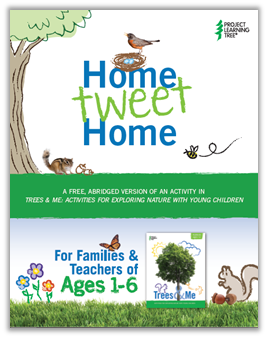
Want to see more?
Explore an abridged version of an activity from the Trees & Me guide.
Note that this is just one simplified version of an activity – 11 more are contained within the full guide!
Learn more about the full set of activities and ideas for exploring nature with young children.
Watch the webinar


